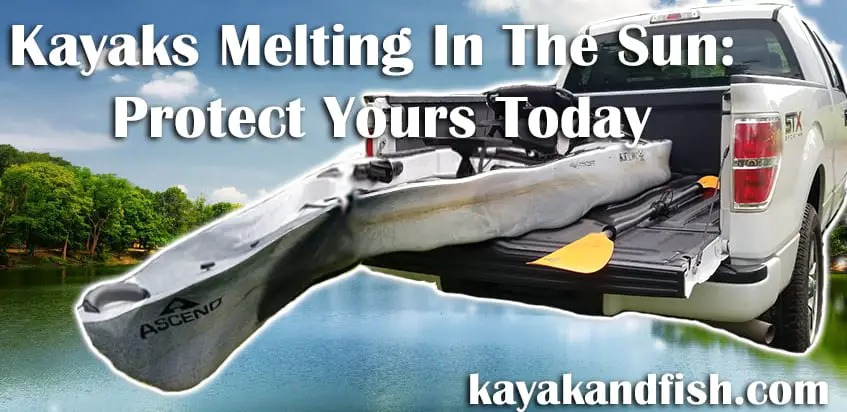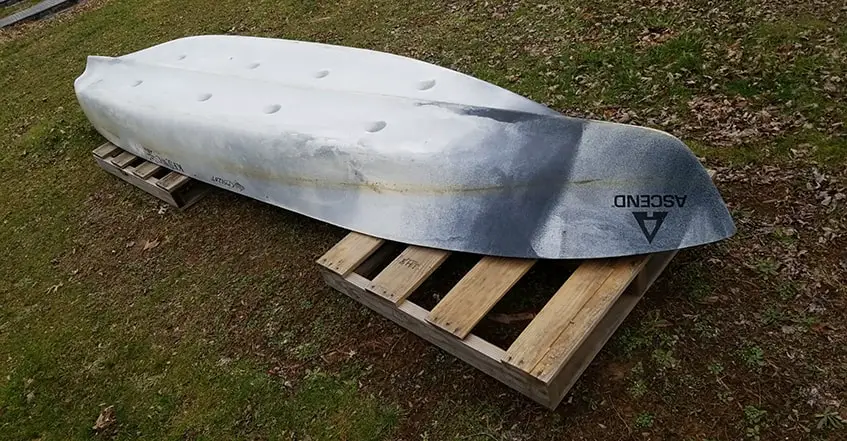
I have seen some folks store their kayaks in interesting ways. One time, I was walking up the side of a river doing some smallmouth fishing off the bank and seen one chained to a tree with a lock on it right there on the rocks. No joke, the kayak was full of water, sitting on top of the rocks, and chained to a tree not 5 feet from the water.
Most people take better care of their kayaks than that guy, but what they often forget that kayaks are pretty susceptible to sun damage.
Will A Kayak Melt in the Sun?
Direct sunlight all day every day isn’t good for anything and if you can store your kayak inside of a building, that is ideal.
The short answer, simply put, is your kayak will absolutely melt under the right conditions. Under normal conditions, you shouldn’t worry about your kayak melting away but your kayak can become deformed after being exposed to extreme heat.
Let’s explore what conditions you have to meet in order to melt a kayak and what you can do to keep your kayak safe from the heat and the sun.
What Temperature Does Polyethylene Melt?
Commercial, low-density polyethylene is what is used to make kayaks which has a melting point of 221 and 239 degrees, Fahrenheit. Sounds pretty insane that a kayak can reach that kind of temperature, doesn’t it?
That is the temperature at which the plastic begins to liquidize, which in terms of kayaks, the damage has been done long before this.
When the plastic of your kayak is exposed to long periods of heat and sunlight, it will begin to begin a process called “oil canning”.
What is “Oil-Canning”?
Oil canning is a term used to describe indentions that form on the bottom of your kayak caused by conforming to the surface it is sitting on, usually caused by intense heat or being tied down too tightly.
Oil-canning creates these dents or flat spots in the hull of your kayak and it will affect the way water flows along the bottom. This will cause your kayak to track funny or affect how much speed your kayak can get.
The damage of oil-canning is serious damage to your kayak and it will greatly reduce the life of the vessel. You can use a heat gun or hairdryer to pop dents back out in an attempt to increase the life-span of the worn kayak.
The thing that makes oil-canning so common is that it doesn’t take extreme temperatures for this to occur. Direct sunlight on a decently warm day is still threatening to your kayak and dark kayaks are far more susceptible.
I wrote an article about fixing dents and large cuts in kayaks that you can read here: How to Repair your Kayak and Keep it in Good Condition
Oil-canning is the most common type of damage to a kayak and the most preventable.
How to Prevent Oil-Canning and Melting
Prevent oil-canning and melting of a kayak in the heat of the day is actually pretty simple: By Storing or transport your kayak on its side, which is the strongest point of the kayak.
If you’re transporting the kayak on the roof-rack of an SUV or car, a good set of J Bar Racks (Amazon) will do the trick. You can also pick up a pair of J-Hooks for the wall of a garage or inside of a storage building for safe and effective storage.
If you don’t want to spend money on the racks and hooks or you are transporting your truck in a truck bed, you can simply lay the kayak on its top. This will prevent damage to the hull of your kayak, which is the most important part of the kayak since it directly interacts with the water and affects the movement of the vessel.
Remember: When storing a kayak in the yard or garage, keeping it out of direct sunlight and on its side is the best approach.

Not Only Heat but Sunlight Damages a Kayak
Being stored outside or in direct sunlight for a long amount of time will also cause damage to the kayak. UV rays from the sun break down the polyethylene in the kayak which will cause the kayak to break.
We have all seen sun damage on plastic before and it looks the same on a kayak. Sun damage will appear as large discolored places on the kayak, if you have a kayak that used to be red and now looks more like a pink color now, this is sun damage.
Sun damage may also make areas of the kayak appear to be dried out or crack.
Sunscreen for a Kayak?
There is actually a cool product that is available for kayakers to use to protect their vessels against sun damage. Personally, I don’t know anyone who leaves their kayak exposed to the sun for prolonged periods of storage or anyone who uses this product but I have seen it mentioned on various forums or brought up in topics regarding sun exposure on a kayak so it is worth mentioning.
303 Aerospace Protectant (Amazon) is easy to apply and comes in a spray bottle. All you have to do is spray it on your kayak and rub it in with a clean cloth.
Depending on how often you use your kayak will change how often you need to reapply the spray. An easy way to check and see if the spray needs to be reapplied, look at how water sits on the surface of your kayak. If the water drops bead, you’re good.
Make sure that you clean the surface of your kayak well before applying the spray to ensure that it applies and sticks evenly.
How to Properly Store a Kayak in between Use
Like I mentioned above, J-Hooks are the absolute best way to store a kayak for the long haul. If you don’t have somewhere capable of mounting the hooks or are forced to store your kayak outside, I’ve got you covered with the next best options.
You can hang your kayak on the wall vertically too, you just want to make sure that it is secured properly.
Storing Your Kayak Indoors
Indoor storage, on the floor, is the next best option compared to J-hooks. The major downside to storing your kayak on the floor is that it takes up A LOT of space.
Leaving your kayak on the floor is not ideal but as long as it is indoors, like in a garage or out-building, it will be fine for short periods of storage. Even better if space is climate controlled or well shaded.
Some people store their kayaks indoors on top of milk crates. I advise against that because it doesn’t evenly distribute the weight along the bottom of the kayak but instead on the two points that are touched by the milk crates.
Another good option is to store your kayak by suspending it from the ceiling. This is a lot of hassle, in my opinion, but could work in the right situation.
Storing Your Kayaking Outside
Storing a kayak outside is iffy at best but can be done. The main focus is keeping the kayak out of the sun and away from the elements.
The best way to store a kayak outside, in the open, is to store it off of the ground using pallets and covered with a tarp. Placing the kayak upside down will help the bottom keep its shape and keep rain from gathering on top of the tarp in the kayak’s holes.
Even though the tarp will keep the sun from directly reaching your kayak, you should store it in an area that is shaded throughout the majority of the day.


